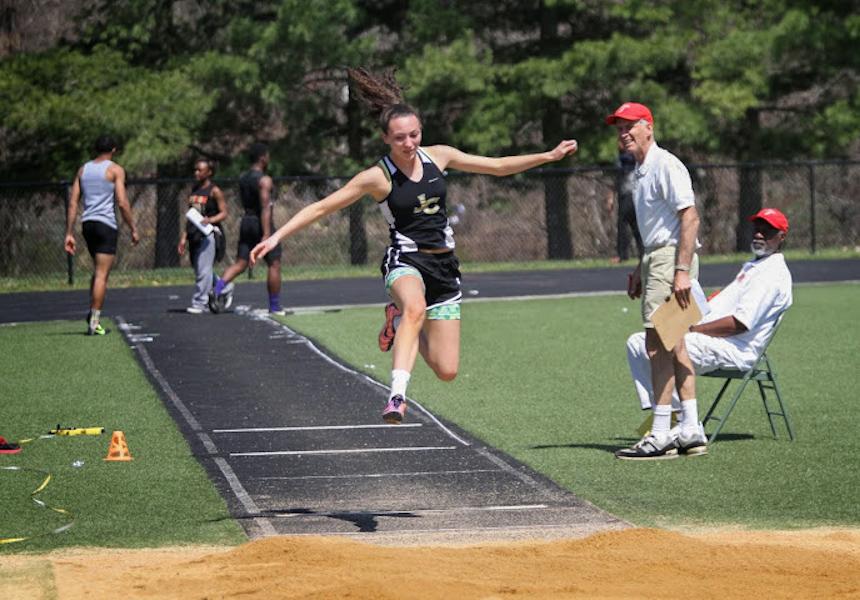Leaping toward victory
The Patriot jumps into track and field events and looks at what it takes to succeed in them
300m Hurdle
Sophomore Kristen Isoldi surges over the last hurdle, keeping her eyes forward with determination to win. On her tail are girls from other schools trying their hardest to beat her, but Isoldi sprints to the finish line and beats them all as track and field coach Rob Torres presses a button on his stopwatch: 46.4 seconds, Isoldi’s best time yet.
“300-meter hurdles are very hard because you have to keep up a fast running pace, [while also] jumping over eight hurdles,” Isoldi said. “It is a very tiring event.”
“The 300 hurdle event requires strength and stamina that the other events do not,” coach Mike Monaghan said. “The last two flights of hurdles can make or break the race because the athletes are usually tired at this point.”
The recipe for this event, according to Torres, includes three ingredients: “[being] a good 200 [or] 400 runner, being a good hurdler with proper form, and having the strength to hold that form for the entire race while running at or near top speed.”
Sophomore Holly Driver said that “if I didn’t have Kristen to run it with, I would be dreading it every meet.” Driver isn’t a fan of this race because she believes that she is “better at the 100 hurdle, and the 300 is really tiring with hurdles in the way.”
Isoldi, however, enjoys the race.“I love the 300 hurdles because it is the best feeling when I complete the race. Even though the race is hard, I enjoy doing it every time because hurdles are a lot of fun.”
Long Jump
A perfect snow angel lays on the ground. Or rather, sand angel. Senior Catey Minnis gets up from her sprawled position on the sandpit and dusts herself off. It isn’t over yet. She needs to practice this jump for the upcoming meet, so she strides back to the start and jumps again, landing the correct way this time. Long jump is rough, but she won’t give up.
“The long jump is one of the two horizontal jumps, along with the triple jump,” coach Rob Torres said. “The most important thing that helps someone jump well is speed. The idea is to run as fast as you can down the runway and hit the take off board with no room to spare, driving your lead leg up and jumping as far as possible.”
Minnis agreed, saying that “the best technique is running as fast as you can to increase the momentum to carry you farther into the pit.”
It is important where the jumper’s foot leaves the ground, according to Torres. “If you jump after the take off board, it’s a foul and doesn’t count. If you jump before the take off board, it counts, but they measure to the board, so you lose distance.”
A typical long jumper is also “a high jumper and sprinter,” as Minnis is, Torres said.
“People think that all it is is just raw ability, but you have to put in work and get steps to actually be good,” sophomore Mitchell Hopkins said. Hopkins long jumps for the men’s team. “There is more technique than people realize.”
Pole Vault
Junior Drew Cook soars through the air and over the bar. Plopping on his back, he looks up to see that the pole vault bar is still precariously suspended in the air, but in no danger of falling on him. Thankfully, he cleared it and will advance to the next level.
Cook is one of two boys who pole vault, the other being senior Alex Brewer.
“There are so many components [that go] into the process of pole vaulting,” Cook said. “It uses all aspects of a sport: speed, strength, coordination, and technique.”
“The pole vault is an event where you run down a runway holding out a 10-14 foot pole,” coach Rob Torres said. “At the end of the runway, you plant the pole into a box and vault over a bar anywhere from six feet to as high as you can go.”
According to Torres, the average height that girls pole vault is 6-10 feet, while the guys tend to get a height anywhere from 8-12 feet. “There are some who go higher than these heights, but it’s kind of rare.”
Though pole vaulting may appear dangerous and scary, vaulters say otherwise.
“Once beginners get past the initial fear of running full speed at a box and being expected to jump super high in the air, the fun begins,” Heather Kirwan, class of ’12 and former pole vaulter, said.
Though Kirwan is a sophomore at Towson University, she comes to JC once in a while to help teach the pole vaulters the correct technique. “It’s been a lot of fun showing [them] the technique.”
In order to be a good pole vaulter, “you need to conquer the initial fear of getting yourself high in the air and being temporarily vulnerable,” Torres said. “You end up landing on a big, cushy pit, so injuries are rare.”
Torres also remarked that “it is a very fun event to do once you start to have some success in it.”
Indeed, Cook “absolutely loves pole vaulting” and Kirwan said that “pole vaulting has been my favorite sport.”
Elizabeth Driver is a Sports Editor for The Patriot and jcpatriot.com.



